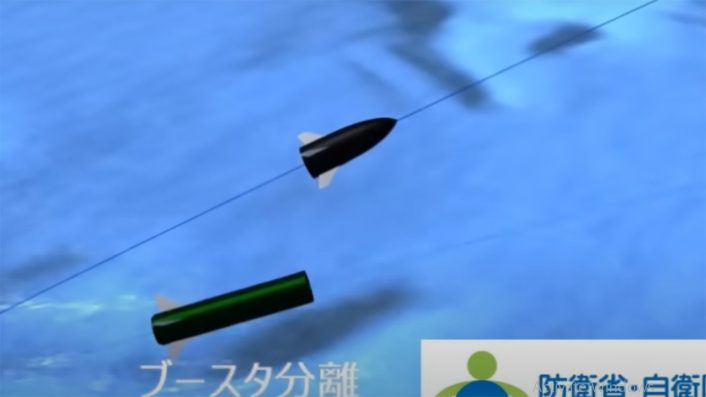Japan is strengthening its stand-off defense capabilities to quickly and remotely intercept and eliminate invading forces.
Japan conducted the first test of its hypersonic weapon on Mar. 23, 2024 in the United States, reports on Jul. 4 said quoting Tokyo’s ATLA (Acquisition Technology and Logistics Agency). The ATLA is a part of the MoD (Ministry of Defense).
The video footage and the computerized graphic of the test launch, released only now, described it as a “High-Speed Gliding Missile for Island Defense,” suggesting the hypersonic weapon is of the boost-glide vehicle category. The weapon is planned to be deployed by the JGSDF (Japan Ground Self-Defense Force).
The missile “is a long-range missile scheduled to be deployed from fiscal year 2026,” the report mentioned. After being launched by a booster from a ground-based launcher, “the detached warhead will glide like a glider and attack targets hundreds of kilometers away,” continued the report. Illustrations showed the warhead ‘skipping’ under the atmosphere – a common feature of HGVs – and then diving down on the target at a near vertical 90 degree angle.
The MoD posted on X, while sharing the launch video, that Japan “is strengthening its stand-off defense capabilities in order to quickly and remotely intercept and eliminate invading forces against our country.” In this context, it also mentioned signing an agreement to acquire the US-made AGM-158 JASSM (Joint Air-to-Surface Standoff Missile) and “conducted a pre-launch test of a high-velocity gliding missile for island defense.”
The test
According to the ATLA, the test was conducted in California, and the goal was to “confirm the measurement system.” Additionally, the “performance required for future launches was also confirmed, so they will continue to conduct staged performance confirmation, including launch tests.”
This literal automated translation off the web page means that the scope of the test was very basic, usually meant to validate elementary propulsion, materials and vital electronic, electrical and structural assemblies, with more test fires required to confirm the system’s full capability in all its stages. It is not known if the HGV separated from the launch vehicle and landed on a target.

As for the question why the test was held in the US, the reason could be diplomatic, since Japan wouldn’t want to escalate tensions with North Korea in far northeast Asia. A military reason could also be preventing advanced Chinese electronic, satellite and optical surveillance from snooping on the test.
What the video shows
The video released by ATLA contains the illustrated video and the footage of the actual launch off the California coast, from four different angles. One is from a distance, two others from close to the launcher and the fourth a long shot that captures the entire beach and the missile’s journey into the sky.
The front section of the missile can be seen with four fins as it just leaves the TEL (Transporter Erector Launcher). This can be assumed to be the HGV that would separate upon reaching the upper atmosphere.
Before the actual launch footage, the graphic showed a road-mobile truck-mounted launcher that launches a missile, then the HGV warhead separates and performs ‘skipping’ maneuvers, before descending down vertically.

What are HGVs?
HGVs are carried on top of medium and long-range rocket boosters, where the front warhead section detaches just below the upper atmosphere. This requirement to be ‘boosted’ before being released also led them to be called hypersonic ‘boost glide vehicles.’
The boosters of a medium or long-range ballistic missile, which might also be nuclear tipped, go well past the atmosphere and then descend down before separating in a classic parabolic trajectory. During the descent stage, the single warhead or MIRVs (Multiple Independently targetable Reentry Vehicles) carrying multiple warheads of the nuclear-tipped ballistic missile, however, can also touch hypersonic speeds of well above Mach 7. Some have been known to clock speeds of up to Mach 10.
The operational principle of an HGV is similar to a MaRV (Maneuverable Reentry Vehicle), since they can significantly alter their trajectory post-release. This makes HGVs difficult to intercept by air defense systems. Russia’s Avangard, deployed on an SS-19 land-based long-range ballistic missile, and China’s DF-ZF belong to the HGV/Hypersonic Boost Glide type.
Speaking in context of hypersonic weapons threats to the US, a CRS (Congressional Research Service) report from Mar. 2024 said, “(An) HGV’s novel trajectory and maneuverability in flight would complicate an effort to detect, track, and defend against an attack. The United States would likely detect the booster’s launch, as it would for the launch of any ballistic missile, but it would not be able to predict the HGV’s flight path.”
“In addition, although an HGV launched by a rocket booster would reach its target far more quickly than a warhead delivered by an aircraft or subsonic cruise missile (in minutes instead of hours), it would not travel faster than a ballistic reentry vehicle,” continued the report. “However, it would be more difficult to predict the intended target and to direct missile defense interceptors toward the attacking HGV.”
The other existing category of hypersonic missiles are hypersonic cruise or aero ballistic missiles, which are powered by a powerful scramjet all throughout their flight and are released from an aircraft. Russia’s Kh-47M2 Kinzhal, launched from the ‘K’ variant of the MiG-31, and the US’s AGM-183 ARRW (Air-Launched Rapid Response Weapon), tested from the B-52H Stratofortress. belong to this category.

